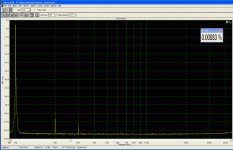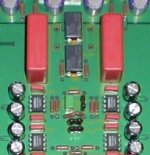A relay to switch phono cartridge loading?
Please tell what relay is close to being good enough for this ultra crucial job?
REgards, Allen (Vacuum State GmbH)
Please tell what relay is close to being good enough for this ultra crucial job?
REgards, Allen (Vacuum State GmbH)
PMA said:
Speakers: Nobble Audio Lucid (bass ScanSpeak as in W.A. Sophia, middle and high Thiel & Partner as in Avalon, Mundorf coils and capacitors)
Sorry for the typo, it is Noble Audio 😀
Allen Wright said:Please tell what relay is close to being good enough for this ultra crucial job?
This is what I'm trying to use:
http://pewa.panasonic.com/pcsd/product/sign/pdf_cat/rp.pdf
Has silver alloy contacts and it's available at DigiKey. If you are aware of any better switching solution, just let me know.
Bonsai said:When seeking the truth
leave no guru unstoned
Superb!
😀
Thanks, I actually made that up by accident after recieving a brickbat in an email for daring to question someone's audio "guru". The multiple meanings are more fun than turning "question authority" around and around.
BTW syn08 I fully agree that op-amp phono's can sound just fine. I still would have a hard time living with a power supply that noisy. It would be interesting to see the PSRR of the standard op-amp phono with a 47k cartridge and the input capacitance unbalance.
scott wurcer said:
It would be interesting to see the PSRR of the standard op-amp phono with a 47k cartridge and the input capacitance unbalance.
I'll let you know as soon as I will be ready to measure the PSRR. BTW, randomly picked OPA827 measures at about 2.2+/-0.5nV. If anybody is aware of a better JFET input opamp, speak now or forever hold your peace.
>Has silver alloy contacts and it's available at DigiKey. If you are aware of any better switching solution, just let me know.<
$20 each, they had better be good...!
I don't ever consider putting any form of switch in a cartridge's signal path, and a loading R is certainly in the path.
In our two tube preamps we parallel input sockets, one for the lead from the cartridge, the other for loading Rs.
The middle priced SVP-2 gets an extra RCA socket, but our fully balanced (actually differential) RTP3D gets a choice of three input sockets, RCA, XLR and REDEL. REDEL is our choice of socket, it's a plastic bodied LEMO, which according to a "GURU" we know, sounds better than a single solder joint.
Maybe, mabe not, but it's certainly WAY ahead of any normal plug/socket system, and cheaper than many "audiophile" RCAs.
Regards, Allen (Vacuum State GmbH)
$20 each, they had better be good...!
I don't ever consider putting any form of switch in a cartridge's signal path, and a loading R is certainly in the path.
In our two tube preamps we parallel input sockets, one for the lead from the cartridge, the other for loading Rs.
The middle priced SVP-2 gets an extra RCA socket, but our fully balanced (actually differential) RTP3D gets a choice of three input sockets, RCA, XLR and REDEL. REDEL is our choice of socket, it's a plastic bodied LEMO, which according to a "GURU" we know, sounds better than a single solder joint.
Maybe, mabe not, but it's certainly WAY ahead of any normal plug/socket system, and cheaper than many "audiophile" RCAs.
Regards, Allen (Vacuum State GmbH)
OP275
OP275, 2008 vintage

syn08 said:
...... If anybody is aware of a better JFET input opamp, speak now or forever hold your peace.
OP275, 2008 vintage

Since they're very careful to spec 3.8nV at 10kHz I'm surprised, but we don't do those at my site these days so I don't scrutinize competitive specs like I used to. Unfortunately the emphasis on high speed lets the low frequency noise suffer so things in the works probably are not best for audio.
Allen Wright said:
I don't ever consider putting any form of switch in a cartridge's signal path,
Good point. I got a PO this year to design an MC preamp for production company. I did, and insisted to put no switches in a cartridge's signal path. The company had their own notions, so we finished halfway. I made an uncompromised prototype without input switch, and guaranteed parameters for such solution. Their designer will add all those switches in their responsibility.
>Their designer will add all those switches in their responsibility.<
Exactly!
Way back, I used to make Pizza money by bypassing all the switches in the newly arrive NAD gear. Improved it by an amazing amount!
BTW, did you get my private mail asking about your comment regarding lateral MOSFETs?
Regards, Allen (Vacuum State GmbH)
Exactly!
Way back, I used to make Pizza money by bypassing all the switches in the newly arrive NAD gear. Improved it by an amazing amount!
BTW, did you get my private mail asking about your comment regarding lateral MOSFETs?
Regards, Allen (Vacuum State GmbH)
Allen Wright said:
BTW, did you get my private mail asking about your comment regarding lateral MOSFETs?
Please resend, I am afraid it has finished in the spam bin. Thanks.
PMA said:As John has already said, power supply is a very important part of the preamplifier.
But Sir, where is the PS? Outboard? Surely the shown PS is just sufficient to power the front panel LED...
PMA said:Prejudice. The preamp excels in solid bass.
I guess some people were also making Pizza money by changing transformers, not neccessarily in NAD gear 😉
PMA said:
My contemporary small audio activities can be considered rather like a hobby.
PMA said:
I got a PO this year to design an MC preamp for production company.
An audio hobbyst owing a company ("Macura Instruments") that is advertizing and selling "Dispre II" kits and takes commercial orders from other companies.

Not a problem, as long as you would move your stuff to the dedicated section on this forum. It would also be nice if you could spend some time and effort educating and helping your peers, rather that endlessly self advertizing, spreading around smoke screens and serenading JC.
Syn08, now you are getting nasty! Why don't you learn and grow, rather than belittle and inhibit?
Syn08,
This was my private mail question that hityour spam filter:
You write on your website the following about lateral MOSFETS in a power output stage:
>The reason to chose lateral MOSFETs was entirely based on their self-protecting nature. It is in our belief that an I/V protection circuit that would not interfere with the AC performance doesn’t currently exist. Therefore, vertical MOSFETs or power bipolar devices would render an amp that is virtually unprotected to accidental (short circuits) or difficult speaker loads. Lateral MOSFETs have the unique property in that their transconductance collapses at high currents, being therefore more tolerant to abuse<
This is new info to me and not observed in the respective lateral MOSFET datasheets. There is no sign of any transconductance loss at high curerents to my eyes.
Can you give further references to this?
Regards, Allen (Vacuum State GmbH)
This was my private mail question that hityour spam filter:
You write on your website the following about lateral MOSFETS in a power output stage:
>The reason to chose lateral MOSFETs was entirely based on their self-protecting nature. It is in our belief that an I/V protection circuit that would not interfere with the AC performance doesn’t currently exist. Therefore, vertical MOSFETs or power bipolar devices would render an amp that is virtually unprotected to accidental (short circuits) or difficult speaker loads. Lateral MOSFETs have the unique property in that their transconductance collapses at high currents, being therefore more tolerant to abuse<
This is new info to me and not observed in the respective lateral MOSFET datasheets. There is no sign of any transconductance loss at high curerents to my eyes.
Can you give further references to this?
Regards, Allen (Vacuum State GmbH)
- Home
- Source & Line
- Analog Line Level
- New DISPRE preamp, successor to previous popular version

